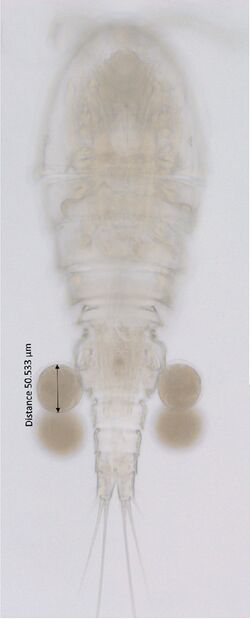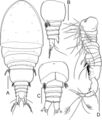Biology:Bryocyclops
| Bryocyclops | |
|---|---|

| |
| Bryocyclops muscicola | |
| Scientific classification | |
| Domain: | Eukaryota |
| Kingdom: | Animalia |
| Phylum: | Arthropoda |
| Class: | Copepoda |
| Order: | Cyclopoida |
| Family: | Cyclopidae |
| Genus: | Bryocyclops Kiefer, 1927 |
Bryocyclops is a genus of freshwater-dwelling cyclopoid copepods. The epithet Bryo- for Bryophyta (Mosses) refers to the fact that the first few species were described from mosses.[1]
Distribution
Species belonging to this genus are distributed in all major biogeographic realms except Antarctica, although there are only a handful of species from the Nearctic (B. muscicola) and Neotropical realm (B. campaneri and B. rochi)[2][3][4]. Researchers suspect that with increasing sampling efforts, more species will be discovered from these regions. Apart from continental habitats, some species occur on the oceanic islands of Guam, Fiji, Tonga, Samoa[5] and Christmas Island. In recent years, five new species have been described from caves in Thailand.[6]
Habitat
As its name suggests, the type species was found in damp mosses.[1] Apart from other microcrustaceans such as cladocerans, ostracods and harpacticoid copepods, only a few genera of cyclopoid copepods have managed to access semiterrestrial habitats like mosses, leaf litter, tree holes, leaf axils, bromeliads and other phytotelmata, or even man-made microhabitats (water-filled tin cans, car tires).[5][7] These habitats pose serious challenges to fully aquatic organisms, especially since they rely on passive means of dispersal (phoresis[8]). Species of the genus Bryocyclops also inhabit cave pools, groundwater and other freshwater bodies.
Species
This genus currently contains 26 valid species:[9]
- Bryocyclops (Palaeocyclops) jankowskajae Monchenko, 1972
- Bryocyclops absalomi Por, 1981
- Bryocyclops africanus Kiefer, 1932
- Bryocyclops ankaratranus Kiefer, 1954
- Bryocyclops anninae (Menzel, 1926)
- Bryocyclops apertus Kiefer, 1935
- Bryocyclops asetus Watiroyram, 2018
- Bryocyclops bogoriensis (Menzel, 1926)
- Bryocyclops campaneri Rocha & Bjornberg, 1987
- Bryocyclops caroli Bjornberg, 1985
- Bryocyclops chappuisi Kiefer, 1928
- Bryocyclops constrictus Lindberg, 1950
- Bryocyclops correctus Kiefer, 1960
- Bryocyclops difficilis Kiefer, 1935
- Bryocyclops elachistus Kiefer, 1935
- Bryocyclops fidjiensis Lindberg, 1954
- Bryocyclops jankowskajae Monchenko, 1972
- Bryocyclops maewaensis Watiroyram, Brancelj & Sanoamuang, 2012
- Bryocyclops maholarnensis Watiroyram, Brancelj & Sanoamuang, 2015
- Bryocyclops mandrakanus Kiefer, 1954
- Bryocyclops muscicola (Menzel, 1926)
- Bryocyclops muscicoloides Watiroyram, 2018
- Bryocyclops parvulus Kiefer, 1928
- Bryocyclops phyllopus Kiefer, 1935
- Bryocyclops trangensis Watiroyram, 2018
- Bryocyclops travancoricus Lindberg, 1947
Gallery
References
- ↑ Jump up to: 1.0 1.1 Kiefer, Friedrich (1939). "Mission Scientifique de l'Omo. Tome V. Fascicule 56: Crustacea. IV. Copepoda : Diaptomidae, Cyclopidae". Mémoires du Muséum national d'histoire naturelle. 9 (1): 319–378. https://www.biodiversitylibrary.org/part/291680.
- ↑ "Error: no
|title=specified when using {{Cite web}}". http://www.luciopesce.net/copepods/bryoc.htm. - ↑ da Rocha, Carlos Eduardo Falavigna; de Carvalho Bjornber, Maria Helena Gonzaga (October 1987). "Copepods of the Juréia ecological reserve, state of São Paulo, Brazil. II. The genera Hesperocyclops, Muscocyclops, and Bryocyclops (Cyclopoida, Cyclopidae)". Hydrobiologia 153 (2): 97–107. doi:10.1007/bf00006642. ISSN 0018-8158.
- ↑ Gonzaga de Carvalho Bjornberg, Maria Helena (May 1985). "Bryocyclops caroli sp.n. (Crustacea, Copepoda, Cyclopoida), the first representative of the genus in South America". Hydrobiologia 124 (3): 237–241. doi:10.1007/bf00015240. ISSN 0018-8158.
- ↑ Jump up to: 5.0 5.1 Yeatman, Harry Clay (1983-12-01). "Copepods from microhabitats in Fiji, Western Samoa, and Tonga.". Micronesica: Journal of the University of Guam. 19: 19: 57–90. https://micronesica.org/sites/default/files/copepods_from_microhabitats_in_fiji_western_samoa_and_tonga_micronesica_vol._19_no._1-2_dec._1983-6.pdf.
- ↑ Watiroyram, Santi (2018-10-29). "Bryocyclops asetus sp. n. and the presence of Bryocyclops muscicola (Menzel, 1926) from Thailand (Crustacea, Copepoda, Cyclopoida, Cyclopidae)" (in en). ZooKeys (793): 29–51. doi:10.3897/zookeys.793.25005. ISSN 1313-2970. PMID 30405309. PMC 6218533. Bibcode: 2018ZooK..793...29W. https://zookeys.pensoft.net/article/25005/.
- ↑ Jocque, Merlijn; Fiers, Frank; Romero, Martín; Martens, Koen (2013-07-01). "Crustacea in Phytotelmata: A Global Overview" (in en). Journal of Crustacean Biology 33 (4): 451–460. doi:10.1163/1937240X-00002161. ISSN 0278-0372.
- ↑ Sabagh, Leandro T.; Dias, Roberto Júnio P.; Branco, Christina W. C.; Rocha, Carlos F. D. (2011-04-28). "News records of phoresy and hyperphoresy among treefrogs, ostracods, and ciliates in bromeliad of Atlantic forest". Biodiversity and Conservation 20 (8): 1837–1841. doi:10.1007/s10531-011-0050-z. ISSN 0960-3115. Bibcode: 2011BiCon..20.1837S.
- ↑ "The World of Copepods - Bryocyclops Kiefer, 1927". http://www.marinespecies.org/copepoda/aphia.php?p=taxdetails&id=346880#attributes.
Wikidata ☰ Q6555225 entry
 |









